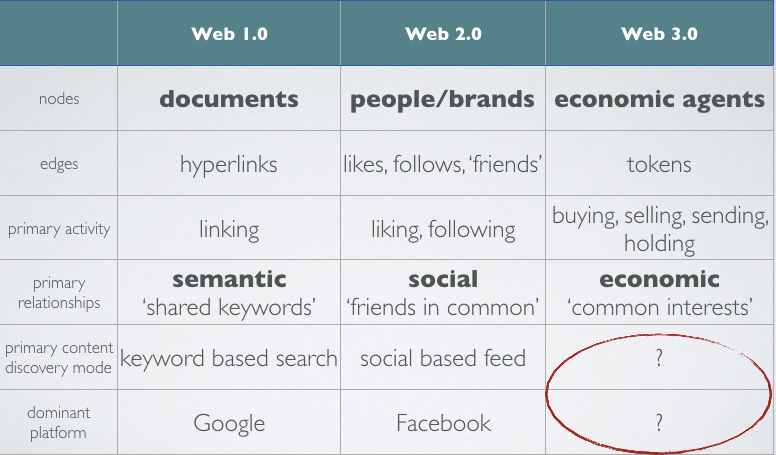Building ‘Google For The Economic Web’ on The Ethereum Blockchain.
Userfeeds is the content ranking & reputation system for blockchain communities. It is inspired by the ideas of liquid democracy and Google PageRank. In the following article, we introduce its vision, economics and the incentive model.
For a TL;DR version you can just browse through the slides from the presentation I gave on the same topic. If you prefer to watch the entire presentation you can find it here.
Introduction
In the early 1990s when the Web 1.0 was in its infancy, the dominant method of discovering websites was through online catalogues like Yahoo. We applied the old discovery model of browsing topically organised paper catalogues to the new medium of digital websites.
The business model was based on keeping users on a site, clicking through the catalogue. Paper catalogues edited by people were around for years and websites were digital ‘pages’ after all. So the ‘directory of digital pages’ was the natural answer to the website discovery problem.
When Larry Page and Sergey Brin wanted to sell their Google search engine in 1998 for $1 million, they were rejected. Their big idea expressed in Google’s PageRank algorithm was that the Web required a new discovery model — a search engine based on links between websites rather than top-down directories. At the time it was a contrarian thought but today we know they were right.
The Economic Web is About People
In our view, we’re at the early days of the new paradigm — the Economic Web enabled by the blockchains and decentralised technologies.
Blockchains can be viewed as distributed databases with access control based on public-private key cryptography. You can find countless discussions on the web regarding the definition what blockchains really are. To us, blockchains are what routers, servers, and networking protocols were to the early Web — the computer-to-computer communication layer that enables new way of human interaction on the layers above.
The Economic Web is the web of humans transacting as economic agents using the blockchains as the interaction layer.
Tokens are new links between people
In our model, tokens are a critical component of the emerging Economic Web. Tokens are for people what code is for machines — a means of programming their behaviours.
Bitcoin proved that it’s possible to use the concept of a token to change economic behaviours of a vast number of people, by linking them into a network and making them perform activity for the network. Tokens proved to be extremely effective motivators as they utilize survival instincts of our brains triggering experiences of gain, loss, fear-of-missing-out on opportunity etc.
We are naturally hardwired to seek economic benefits and tokens exploit that quality of our psychology. We program them but then they start programming us. To economically incentivize large groups of people, distributed around the world, just a few years ago you required to be a government or a multinational corporation. Today, every smart 15-year old with a laptop can achieve the same result with the cryptographic token. Our survival instincts don’t distinguish if the incentive is an apple on a tree, a corporate stock or a cryptographic token you can sell. People will do stuff for the reward.
Economic Networks or the Web 3.0 consist of networks of people linked by ownership of same tokens (there are already thousands of them). This evolution is illustrated in this table:
The Economic Web Needs a New Content Discovery Paradigm.
“History doesn’t repeat itself but it often rhymes” — Mark Twain.
As you can see from the table, we don’t have the native content discovery model for Economic Networks.
FULL ARTICLE:

No comments:
Post a Comment